|
In our first year here friend gave me a Convolvulus
cneorum but I had also just bought one for myself. I planted one
in a spot alongside the road with rocks behind, the other one found a
place on top of rocks where there happened to be quite a lot of soil.
Convolvulus number one soon died. Now I understand why: the soil just
became too hot under its feet. Other plants died there as well: I should
plant cactuses if I did not hate them so much ... The other one thrived on
top of the 'hill' just opposite the kitchen window. Now that was a spot
where our view was taken away by the despised kermès oak which is not pretty to look at. We decided to level down that hill until
we reached bare rocks. So I potted the convolvulus and the work was
done. That sounds easy but actually it was a hell of a job with
many trips to the 'déchetterie', a great deal of carrying heavy stones
and finally the gardener coming in to pull out the stumps of the oak with
his little digging machine. The convolvulus was put in another position
up the hill where it looks fantastic next to the lovely melianthus. It
has a nice way of growing, folding itself into the landscape. Convoluvlus
cneorum is decorated with lovely silvery leaves with a bonus of
large white flowers over a longish period in spring. The surprise was
that among the rocks in the spot where it was before a lot of offspring
appeared and even flowered briefly. So far I love them. The roots seem
to feel at home in the deep cool of the stones. A friend of mine wrote
an article in a Dutch magazine which I more or less know by heart: she
lives in the Ardèche area. She tells you to take cuttings from this
convolvulus as it might freeze in a cold winter. I trim the plant in
spring and use the cut off bits for cuttings. They don't root very
easily, only about half of them will root. You could try with cuttings
taken in late summer as well. |
|
|
Two toppers among the plants in my garden
are Erigeron karvinskii and Ceratostigma
plumbaginoides. The first is a sweet little thing, quite simple,
like a daisy, but unlike a daisy it hardly ever looks untidy. A daisy is
when the first blooming is over full of unpleasant looking finished
flowers. Erigeron always looks neat, though especially after a long
period of heat and drought it may become a little straggly. You can just
cut it off and within no more than two or three weeks the flowering
starts all over again. Only cold in winter or a long period without much
water will stop it. It self seeds and never becomes a nuisance. Youngish
plants may be put in another spot if you water sufficiently until they
have
'taken'. The photo does not really show the potential of this very good
plant.
In the background
a larger Oreganum dictamnus which will be discussed a
little later. Erigeron karvinskii makes a lovely combination with pink Gaura
lindheimii. (photo in the middle) I think its further name may
be 'Siskiyou Pink' - as described in Philippi's catalogue - but I am not
sure. Mine was a nameless present from my daughter Anne Claire. It's a
lovely plant, but a little straggly. The pink one does much better than
the white one and also produces seedlings to be used elsewhere. Gaura is
extremely drought resistant. |
|
|
| Ceratostigma plumbaginoides (photo
above right) starts flowering around the end of July and will keep going until
winter. Its pretty blue flowers are very attractive among gray leaved
plants and it has this lovely habit to grow down among stones if you
plant it on top of a loosely built wall. In autumn its leaves turn bright
red. Then it shrivels and dries out, so that you will have to cut it
back in spring. It is mildly invasive and is said to produce cuttings
easily.
Salvias
|
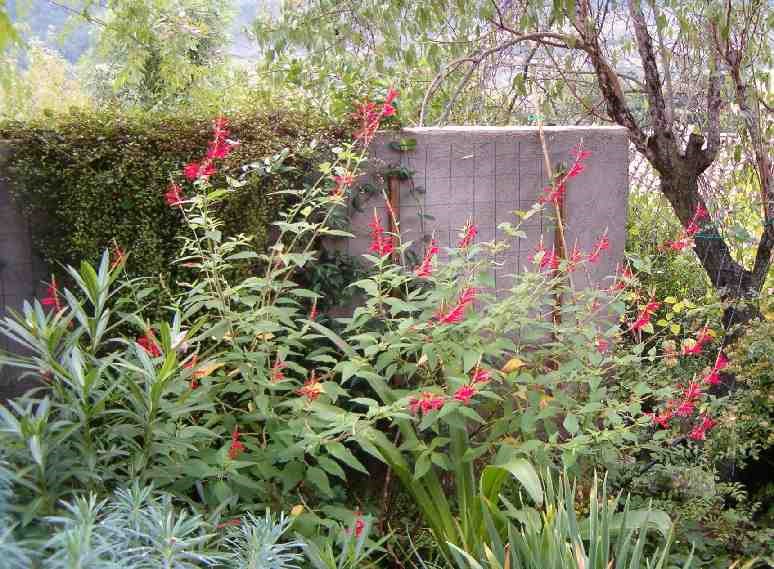
|
|
On the left a photo of
Salvia
elegans 'Scarlet Pineapple'.
I was given a cutting two
years ago and see what it grew up to!
|
On the right the same in close up.
It likes some water,
grows to a meter in height, flowers from the end of September
onwards with quite large, bright red flowers.
|
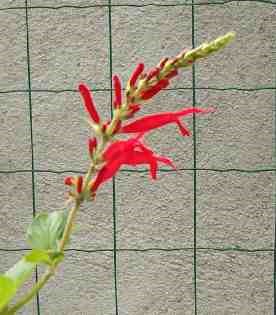
|
|
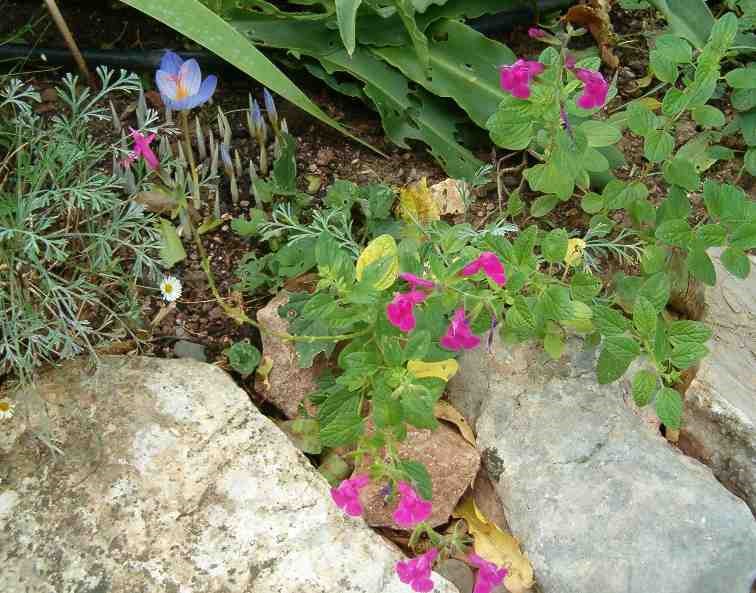
|
Another worthwhile
perennial is Salvia microphylla. I have seen it in bright
blue, red, pale creamy yellow and fuchsia pink. It can stand a lot of
heat and flowers for a long time though a little less in the hottest
month. Needs cutting back in spring. On the left the fuchsia coloured
one raised
by my friend Hieke. |
|
There is an excellent book on salvias, simply named Salvia,
by John Sutton. You could try at Amazon.com on the
internet. Philippi has many different species of salvia.
|
|
|
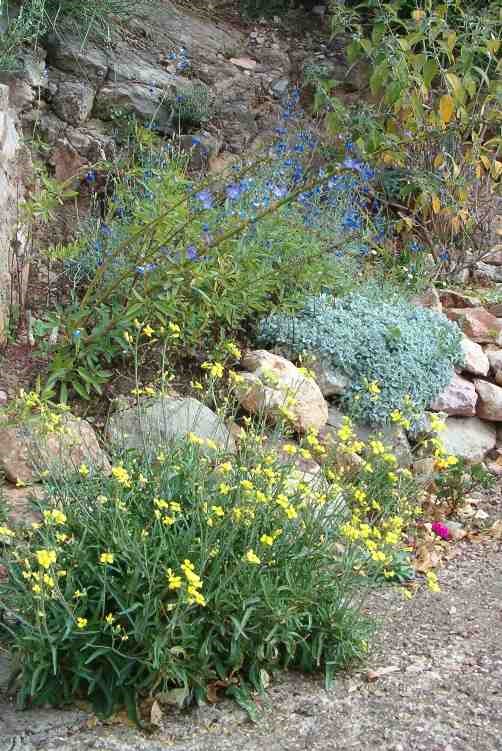
|
Salvia microphylla, described above, with Tanacetum
harajanii growing before it. The tanacetum is a lovely
thing with feathery, downy, silver leaves and extremely well
suited to hot/dry. For sale at Gill's nursery. The yellow
thing in front is ordinary rapeseed, literally growing in
the road. It looks great, doesn't it?
|
 |
Salvia
guarnatica -left- reaches even up to two meters,
with large
flowers in gorgeous darkish blue. It needs a little more water and
a little more shade and does not always survive the winter though
it may appear a little late in season from its rootstock. Quite
spectacular
and very easy to make cuttings from.. |
|
|
I do have more salvias. One is an easily growing, gray leaved,
lowish plant, that expands sideways and has blue flowers in
spring. It is drought resisting and quite beautiful but I am not
sure of its name. In Philippi's catalogue it may be the one called 'Bee's
Bliss'. At Filippi's they say: possibly a cross between two others.
All these grey or blue grey or silvery grey plants match
well and go well with the reddish soil. |
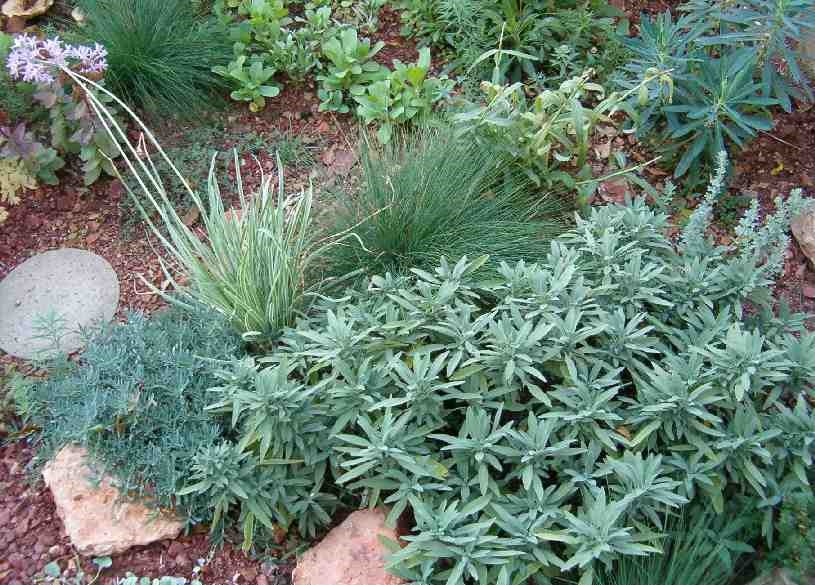
|
I was given Salvia taraxifolia originating from
Morocco, still small here, but full of promise with its silvery,
unusual leaf and the palest pink flowers. From seed ... The well known Salvia
officinalis with purplish leaves always looks nice and always
soon dies for some reason. I have seen a picture with this one combined
with Fritellaria persica and Euphorbia characias, wow! so I tried and
all of them failed. I must have chosen the wrong spot as the euphorbia
is a real survivor.
|
|
| A real gem: Oreganum dictamnus. Its beauty is
best seen when planted on something like a wall or rocks, so that its
hanging flowers show to full advantage. Velvety aromatic leaves, hop like
flowers, 15 cms high, growing in width rather than in height and available
at
Gill's nursery. Extremely worth while. It loves a warm, sunny
position. |
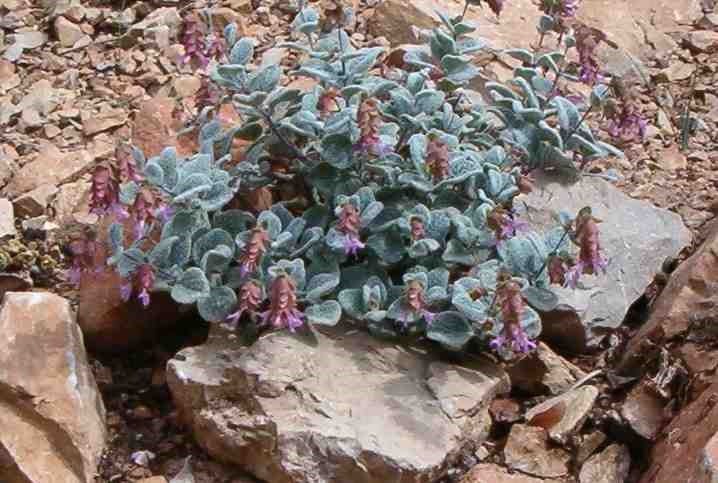
|
|
Leucophyllum langmanae is an attractive bushy plant. Maybe it is a shrub rather than a perennial, sometimes
I
just don't know. It has lovely lilac or pink ( in Leucophyllum frutescens)
flowers
which appear after rain! It should not be watered as it will lose its shape by
too much water. In the photo, below left, you can clearly see that the reddish colour of the
natural environment doesn't go all that well with pink! It does though with gray
and silver. The silvery thing is tanacetum harajanii, the pink flowered one a
kind of silene, I have no name.
Bulbine frutescens 'Hallmark' - I wonder about frutescens: it
means bearing fruit, doesn't it? I never saw any seed on the leucophyllum nor on
the bulbine Yet the bulbine must have produced some as I find baby bulbines all
over the garden. The 'Hallmark' part makes me wonder about an association with
the card people, all very mysterious! The bulbine is a great plant for
this area. I was given a piece by my gardener which grew to a width of some 60
cms in two years' time. Fleshy, green, narrow leaves and spikes of orange
flowers with a yellow centre. It is a busy meeting place for all kinds of bees
and things and needs no water at all. It also comes in a yellow variety. That
one died after its first year here. A car salesman once told me yellow is a bad
colour ... Middle: Bulbine frutescens close-up, right plant as it looks: in
harmony with the colour of the earth and the rocks here! Heartily recommended!
2008: Later I planted another yellow one which thrives. But maybe it can't
survive bad frosts. We have not had any in the last few years. |
|
|
|
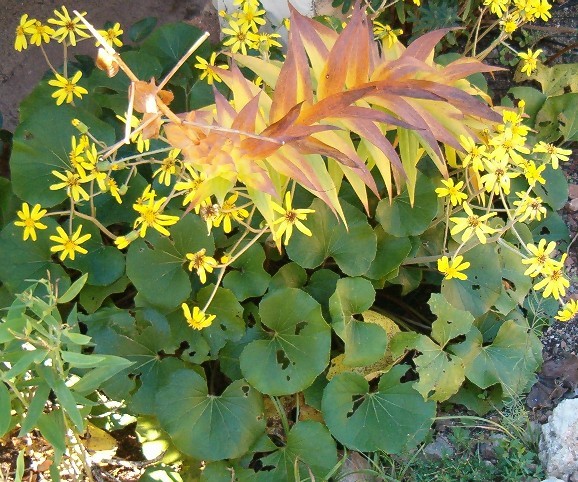
|
Farfugium japonicum belongs
to the ligularia family. This one has firm, round
leaves which give it its ornamental value. I have had
mine for at least ten years. I once bought it at Land's
End!
|
|
To my immense surprise it started flowering
here for the first time, at the end of October.
Unfortunately snails are as fond of it as they are
of other ligularias but the leaves are tougher and
there are fewer snails here. Once you have been able to
find/buy one it is very easy to propagate by
division. |
|
I do not particularly
like thorny or prickly plants. You can't hold them which
causes problems when you have to prune or replant and such.
But yucca is quite lovely in a spot where it can't
hurt you and gets full attention. You only have to cut away
dead flowers once in a very long while. |
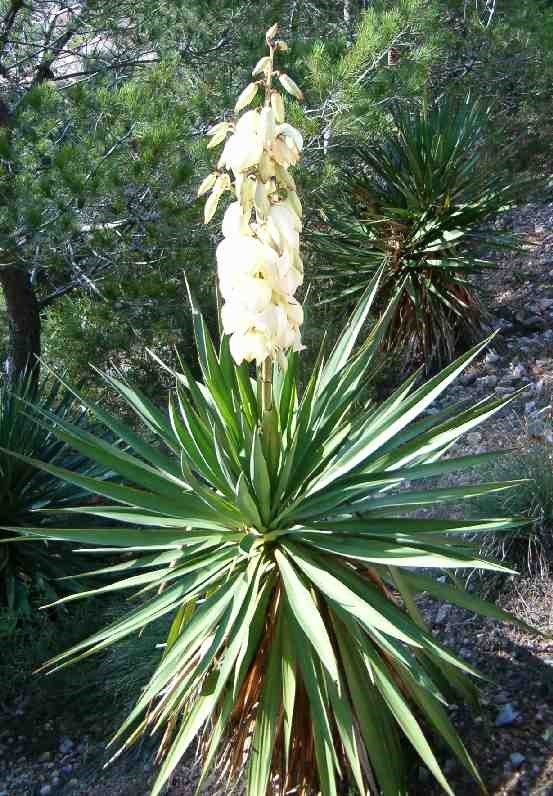 |
| Flowers from the end of
August onwards. The photo is from the last days of October another
specimen was long over. In 2008 it flowered in March ... |
|
|
|
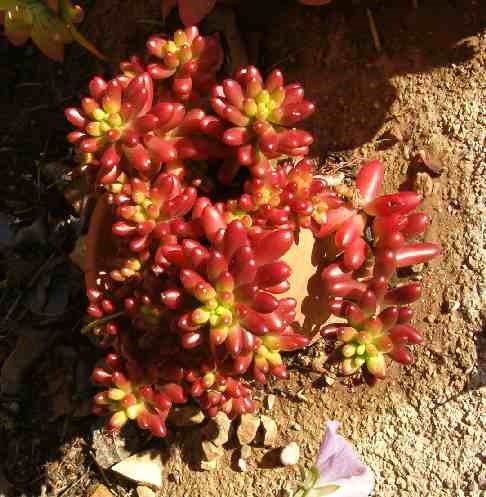
|
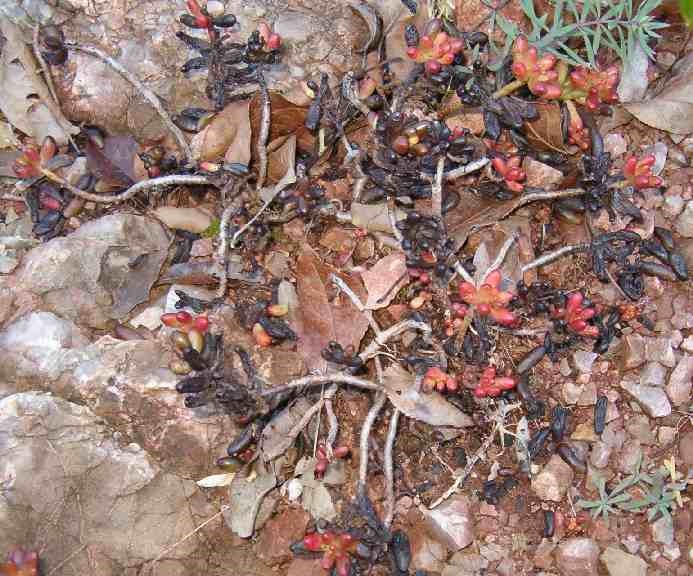
|
31rd January 2006 Not
all goes well. Unexpected hard frost may damage plants in
spots where things grew happily for ages!
Sedum rubrotinctum is a nice little plant for
very difficult spots in the sun. It hardly needs anything. A
bit of lee? No problem. Left.
But this winter it suffered badly from frost in open spots.
The photo on the right shows sad, black remains...
You can grow new plants from just a (fallen) leaf: put it on
the soil where ever you'd like to grow another plant!
|
|
| As is the case after a period of frost seedlings
appear around this time or even earlier under a mother helleborus
when you have been too late to catch the seed, as often happens:
they are always suddenly gone! Today I pricked out some 60, potted
quite a few to eventually give away and planted some out somewhere
just to see if they will grow. They were Helleborus sternii 'Wilgenbroek'
, horrible name! babies. In rich clay they will flower in 3
or 4 years, in poor spots it may take ages. All the same they are
really strong and hardly ever die, even when not all that tenderly
taken care of! Newly planted seedlings will need some watering in
the beginning. When in flower I shall take pictures of the adult
plant which is rather lovely.
|
| One of the very best plants here is Sedum
palmeri . It hardly needs any attention, even in a
pot; in winter its leaves turn an attractive reddish colour;
it flowers very early in the season when hardly anything
flowers yet: pretty and yellow; its is very easy to make
cuttings from: just break of a bit and stick it into soil! A
bit of water will help to make it form roots. In the picture
it is nearly in flower and on its left Sedum
rubrotinctum which survived this pretty nasty winter
without any trouble in a sheltered position in a pot without
any special care but the occasional drop of water. |
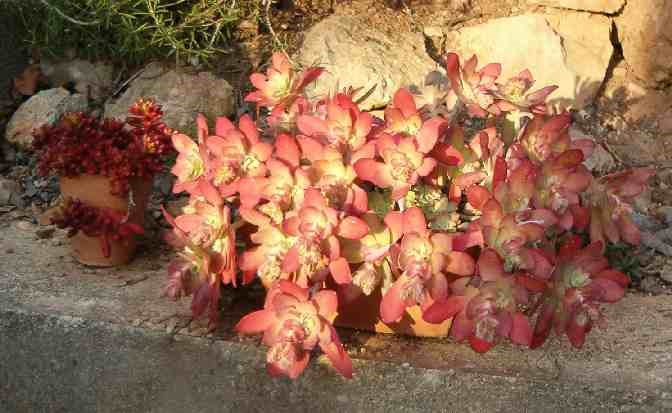 |
| I dug up three of them when leaving
the Netherlands and this one is my favourite: Helleborus orientalis ?
|
 |
Unfortunately no 'colour' name was added. It is
the first to flower. The other two are yellow and white with purple
netting. The yellow one produced a lot of seedlings, but there were
none around the other two.
Whoever wants any is welcome to them. They are very
strong, but may take a few years to start flowering |
 |
|
|
|